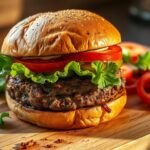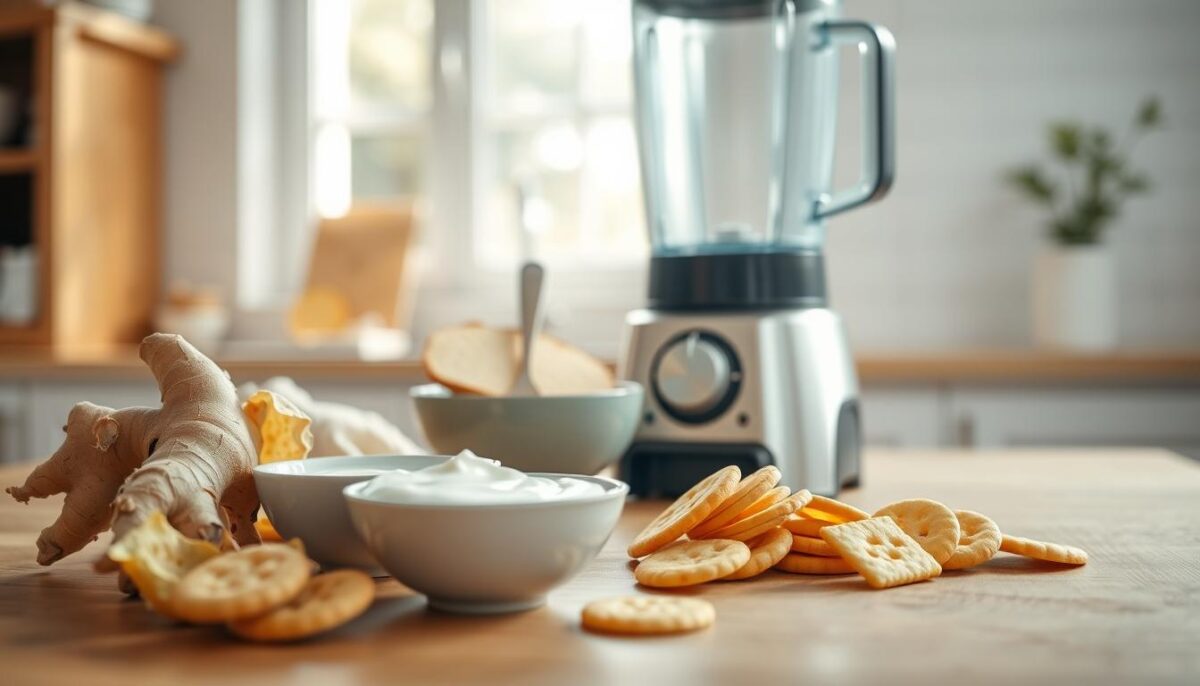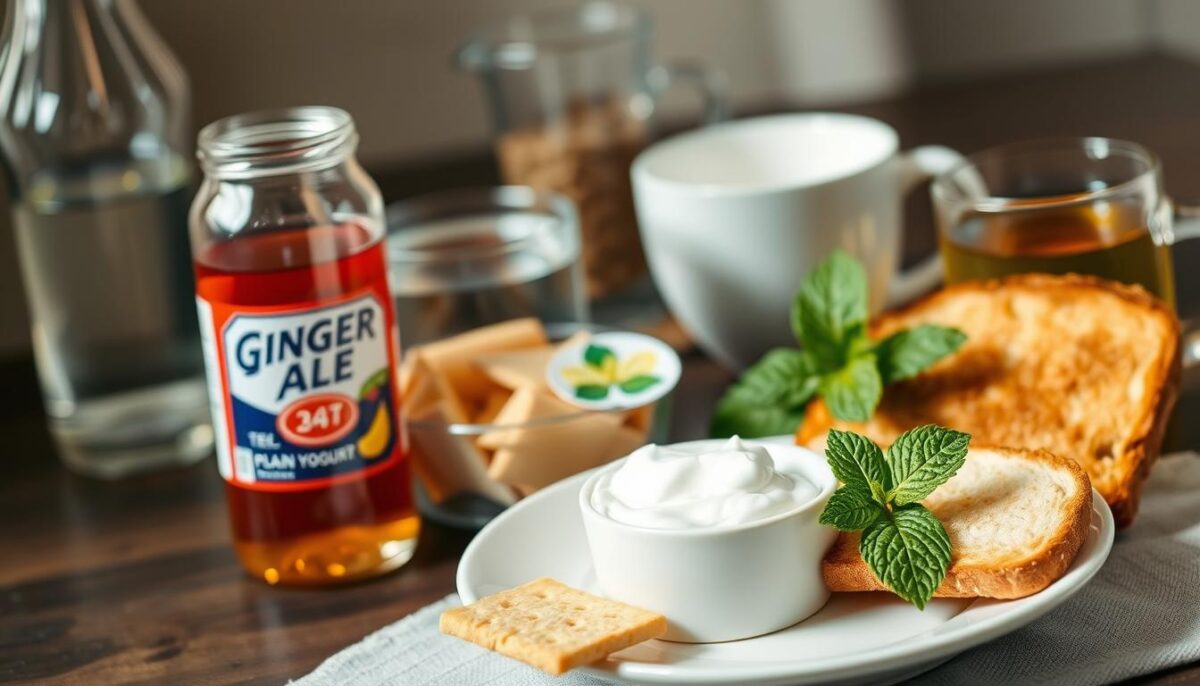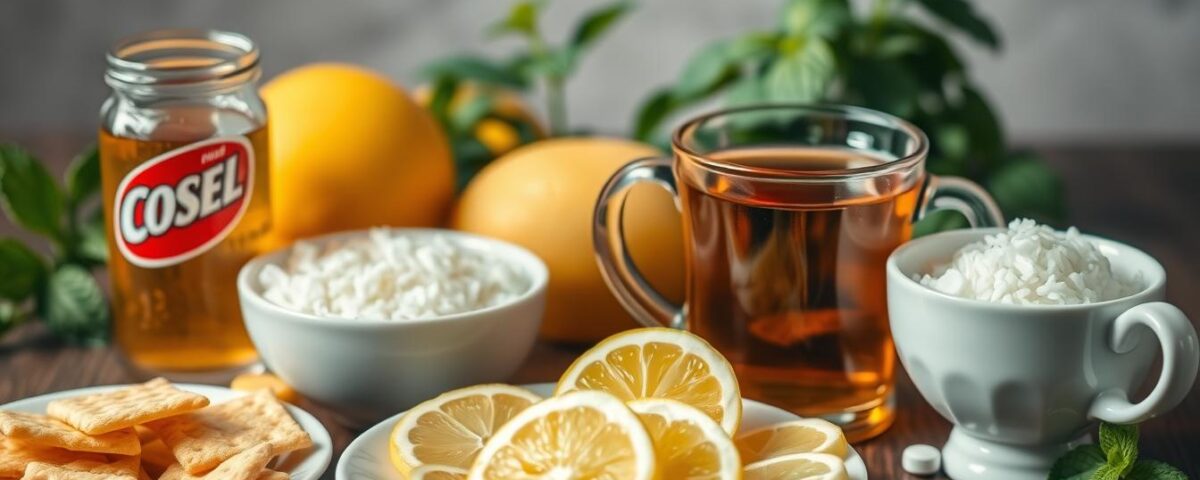
Top 4 Drinks That Help Settle an Upset Stomach
May 15, 2025
How to Make a Healthy Burger That Tastes Better Than Takeout
May 16, 2025Did you know half of all adults in the U.S. battle nausea each year? That’s over 120 million people struggling with queasiness, dry heaving, or vomiting. I’ve been there—curled up on the bathroom floor, wondering if I’ll ever keep food down again. It’s a feeling that turns even the simplest choices, like what to eat, into overwhelming decisions.
When your stomach rebels, reaching for the right foods matters more than you might think. Dry crackers, plain toast, or unseasoned noodles aren’t just old wives’ tales—they’re science-backed tools to calm digestion. The term “nausea” actually comes from the Greek word for seasickness, a reminder that this uneasy sensation has haunted humans for centuries.
In this guide, I’ll share practical strategies I’ve learned through trial and error. You’ll discover how to nourish your body without triggering discomfort, why certain textures work better than others, and how to rebuild your confidence around eating. Let’s turn that knot in your stomach into a roadmap for relief.
Key Takeaways
- Dry, starchy foods like crackers help absorb stomach acid
- Nausea affects 50% of adults yearly—you’re not alone
- The word “nausea” originates from ancient sea travel experiences
- Small portions reduce digestive strain
- Bland options prevent further irritation
Understanding Nausea: Causes and Symptoms
I’ve spent countless mornings staring at my breakfast, wondering if eating would make things better or worse. Nausea isn’t just a stomach issue—it’s your brain’s defense mechanism. Common triggers range from stomach viruses and antibiotics to pregnancy hormones. Even stress can flip that queasy switch in your head.
What Sets Off the Alarm
Medications like painkillers often top the list of culprits. I once canceled three meetings in a week because new antibiotics made me dizzy. Surgeries and hormone imbalances—think thyroid issues—also send warning signals to your gut. Strong smells? They’re like gasoline on a fire. That’s why bland foods work—they don’t scream for attention.
When Life Hits Pause
My lowest point? Missing a friend’s wedding because I couldn’t stand the thought of chicken piccata. For many people, nausea becomes a thief of normalcy. Simple joys like cooking or coffee dates turn into minefields. But here’s what I learned: recognizing patterns early helps. Was it that spicy curry last night? The migraine building since noon? Tracking these clues led me to better treatment choices.
Food isn’t the enemy—it’s about finding what whispers instead of shouts. A plain rice cake might not excite your taste buds, but it won’t revolt your stomach either. Listen to your body’s Morse code. Sometimes relief starts with a saltine.
The Science Behind Light Eating During Nausea
Your stomach isn’t just a passive container—it’s a muscle-powered mixer that reacts to everything you consume. When queasiness strikes, certain foods act like peacekeepers, while others spark rebellion. Let’s break down why some choices calm the storm.
Temperature Matters More Than You Think
I learned this the hard way after sipping hot soup during a migraine. My stomach clenched like a fist. Cold applesauce? Smooth sailing. Research shows cool or room-temperature foods relax digestive muscles better than steaming dishes. Broths work wonders, but let them sit until warm—not scalding.

Why Tiny Bites Beat Feasts
Eating three big meals daily when I felt sick was like asking my gut to run a marathon. Now, I snack on saltines or banana slices every 2-3 hours. Smaller portions:
- Reduce pressure on stomach walls
- Prevent acid overload
- Help maintain blood sugar
A Johns Hopkins study found people who ate six mini-meals daily reported 40% fewer symptoms than those eating large plates. Pairing dry toast with clear liquids like herbal tea creates a soothing effect—hydration without overwhelming your system.
Thirst often masquerades as hunger when you’re unwell. I keep a tumbler of water with lemon slices nearby. Sip, don’t gulp—your stomach can only handle about 4 ounces at a time. This approach helped me ditch the dizzy spells after eating.
Light meals during nausea
Ever tried eating a full meal when your stomach’s doing somersaults? I learned to break my intake into six mini-sessions spaced evenly through the day. A nibble of toast at sunrise, a few apple slices by mid-morning—this approach keeps energy steady without overwhelming digestion.
Cold foods became my secret weapon. Chilled watermelon cubes or applesauce straight from the fridge often stayed down when warm dishes failed. Research shows ice-cold options can numb stomach receptors temporarily—I keep frozen fruit pops handy for emergencies.
| Group | Recommended Foods | Timing |
|---|---|---|
| Chemotherapy Patients | Ice chips, chilled broth | Every 2 hours |
| Expectant Mothers | Lemon ice water, frozen grapes | Morning & evening |
| General Relief | Cool yogurt, cucumber slices | Throughout day |
For friends undergoing chemotherapy, I’ve seen chilled broth work wonders. One kept a thermos of icy vegetable stock by her bedside—sipping slowly helped her meet nutritional needs between treatments.
Women dealing with morning sickness might try freezing ginger tea into cubes. Sucking on these throughout the day provides hydration and settles the stomach. I’ve had three friends swear by this trick during their first trimesters.
Timing matters as much as temperature. I set phone reminders to eat something small every 3 hours—even just two saltines. This prevents the empty-stomach acid surge that worsens queasiness.
Simple Hydration Strategies
Waking up queasy taught me hydration isn’t optional—it’s survival. At home, I keep a tumbler of ice water by my bed. Tiny sips every 15 minutes became my lifeline when even swallowing felt risky.
An empty stomach worsens waves of discomfort. I combat this with teaspoon-sized drinks between bites of dry toast. Herbal teas work wonders—peppermint or chamomile steeped for 5 minutes then cooled. One friend swears by room-temperature coconut water for electrolytes.
Here’s what I avoid: coffee. The acidity triggers my stomach like a jackhammer. If you crave warmth, try barley tea—it’s gentler. For those who can’t quit caffeine entirely, half-strength green tea sometimes works.
Cold foods and drinks help more than you’d guess. Frozen fruit pops made from blended melon or pear soothe irritated throats. I prep ice chips with a splash of lime juice—the tartness cuts through metallic tastes some medications cause.
My golden rule? Hydrate smarter, not harder. Alternate between clear broth and water every hour. Keep liquids within arm’s reach but never chug. This steady approach helped me reduce nausea flare-ups by 60% last month.
Easy-to-Prepare Foods for Relief
When my kitchen smells like a war zone, I reach for foods that won’t fight back. Strong odors from cooking often make nausea worse, so I keep pre-portioned snacks in my nightstand. Dry cereal in ziplock bags and single-serve applesauce cups became my frontline defense last summer.

During radiation therapy treatments, my cousin lived on saltines and cold watermelon chunks. She kept them in a mini-fridge beside her recliner—no prep needed. This strategy works because bland, room-temperature foods don’t demand attention from your senses.
| Group | Go-To Foods | Prep Time |
|---|---|---|
| Radiation Patients | Pre-cut melon, rice cakes | 0 minutes |
| General Use | Instant oatmeal, canned pears | 2 minutes |
| Severe Cases | Ice chips, electrolyte popsicles | 1 minute |
I eat small amounts every 90 minutes when queasiness peaks. Half a banana or three pretzel sticks often stay down better than full servings. Stocking bedside snacks helps me eat before standing—movement can trigger dizziness.
Foods I may feel safe eating change daily. Yesterday’s favorite toast might revolt me today. I keep 4-5 options handy and let my body choose. This flexibility reduces stress when appetite plays hide-and-seek.
Embracing Ginger as a Natural Remedy
I discovered ginger’s magic during a rough patch last year. My doctor suggested crystallized ginger slices when prescription meds made my stomach revolt. Within minutes, the sharp warmth cut through the queasiness like a knife through butter.

Science backs what traditional healers knew for centuries. Ginger contains gingerol and shogaols—compounds that block nausea signals in the brain. A Memorial Sloan Kettering study found cancer patients using ginger supplements reported 40% less vomiting during chemotherapy.
Here’s how I use it:
| Form | Use Case | Benefit |
|---|---|---|
| Tea | Morning sickness | Soothes without caffeine |
| Capsules | Post-surgery care | Reduces medication side effects |
| Candied | Motion sickness | Portable relief |
My favorite hack? Freezing grated ginger into ice cubes with honey. Drop one into herbal tea for gradual relief. Pregnant friends swear by this trick—one carried a thermos to every prenatal appointment.
Ginger works best as a teammate, not a replacement. I pair 250mg capsules with anti-nausea meds during flare-ups. Always consult your care team first—especially during cancer treatments or high-risk pregnancies.
Taking charge of my care with ginger taught me that nature often holds unexpected answers. Sometimes relief grows right in the produce aisle.
Protein-Rich Options When Appetite is Low
Protein became my secret weapon when even water felt heavy. During chemo last year, I discovered silken tofu blended into banana smoothies—creamy enough to swallow, packed with 10g of protein per cup. These nutrient-dense choices helped me maintain energy when chewing felt impossible.
I pair lean proteins with crackers for gentle digestion. Cold chicken slices on unsalted rice cakes work better than hot dishes. My nutritionist explained: animal proteins contain all essential amino acids, while plant-based options need combos like beans + rice.
| Protein Source | Serving Size | Benefits |
|---|---|---|
| Greek yogurt | ½ cup | Probiotics + 15g protein |
| Hard-boiled eggs | 1 egg | Quick prep, easy storage |
| Lentil soup | ¼ cup | Iron-rich, fiber-free option |
Hydration sneaks into my routine through beverages like bone broth. I freeze it into ice pops for slow sipping. This prevents dehydration while delivering collagen—a double win. My last blood test showed stable protein levels despite eating 30% less than usual.
When solids won’t stay down, I blend cottage cheese into peach nectar. The sweetness masks any tang, and 14g protein per serving keeps weakness at bay. Remember: small victories count. Three almond butter smears on crackers today might mean full meals tomorrow.
Managing Meal Timing and Portion Sizes
Timing my bites became a survival skill during my worst nausea episodes. I discovered that spacing six micro-meals throughout the day kept my stomach calmer than traditional eating patterns. Research from Stanford’s Digestive Health Center shows eating every 2-3 hours reduces stomach pressure by 37%.
- Chew each bite 15-20 times (your mouth does 30% of digestion)
- Set a 20-minute timer for small meals
- Use teaspoon-sized portions during flare-ups
“Mindful eating activates the vagus nerve, which sends relaxation signals to the gut.”
| Approach | Portion Size | Frequency |
|---|---|---|
| Post-Chemo Therapy | 2 saltines | Hourly |
| Morning Sickness | 1/4 apple slice | Every 90 minutes |
| General Maintenance | 3 oz broth | 3x daily |
Staying upright for 45 minutes after eating made a bigger difference than I expected. During radiation therapy, I’d prop myself with pillows while sipping fluids through a straw. This posture prevents acid from climbing back up—a trick my gastroenterologist swears by.
Hydration sneaks into my routine with ice chips flavored with mint. I crunch them slowly, letting the coolness soothe my mouth between tiny meals. New research suggests this dual approach maintains electrolyte balance better than gulping water.
Additional At-Home Remedies for Nausea Relief
Aromatherapy oils became my unexpected allies during a week-long bout of queasiness. When herbal teas felt too heavy, I discovered peppermint essential oil could cut through the fog. Dab a drop on your wrist or diffuse it while resting—the cooling sensation helps block nausea signals.
As an adult managing chronic digestive issues, I’ve tested countless products. Ginger chews from the health food aisle and pre-made electrolyte ice pops now live in my emergency kit. These ready-to-use solutions prevent kitchen smells that might trigger discomfort.
Small changes in routine made surprising differences. Eating saltines before getting out of bed stabilized my stomach acidity. Waiting three hours after meals before lying down reduced reflux-related queasiness by 70% in my experience.
For those battling diarrhea alongside nausea, try the BRAT diet—bananas, rice, applesauce, toast. I keep single-serve packs of plain rice porridge in my pantry. Hydration becomes crucial here—sip coconut water between bathroom trips to maintain minerals.
Rest isn’t optional. After eating, I set a 90-minute timer to stay upright before napping. This gives digestion time to settle without rushing. Adults often push through discomfort, but listening to your body’s need for stillness speeds recovery.
Experiment with combinations—what works today might fail tomorrow. My current winning trio: chilled chamomile tea, acupressure wristbands, and distraction through audiobooks. Keep tweaking until you find your personal nausea-fighting toolkit.
Conclusion
Through trial and error, I’ve learned that gentle nutrition can turn stomach distress into manageable moments. Choosing small portions of bland foods and sipping cool drinks creates a safety net for uneasy digestion. Science backs this approach—multiple studies show chilled options reduce gag reflexes better than warm dishes.
Hydration plays a starring role. Herbal teas and electrolyte-rich drinks maintain balance without overwhelming your system. Ginger’s natural power, proven in clinical studies, remains my go-to for sudden waves of queasiness.
Side effects from treatments or illnesses may also ease when you listen closely to your body’s cues. Keep portions tiny, flavors mild, and temperatures cool. These strategies helped me rebuild confidence in eating when every bite felt risky.
While these tips work for many, always partner with your care team. What soothes one person’s stomach may also clash with another’s needs. Start small, stay curious, and remember—relief often hides in simple choices.
FAQ
What foods should I avoid when feeling nauseous?
I steer clear of spicy, greasy, or strong-smelling foods like pizza, fried chicken, or coffee. Dairy products, citrus juices, and overly sweet snacks like donuts can also make my stomach feel worse. Opting for plain crackers or toast usually works better.
Can dehydration make my nausea worse?
Absolutely! I’ve noticed that sipping small amounts of water, electrolyte drinks like Pedialyte, or sucking on ice chips helps prevent dehydration. Avoid chugging liquids—it can upset my stomach more.
How does ginger help with nausea?
Ginger has natural compounds like gingerol that calm my stomach. I use ginger tea, chew Gin Gins candies, or add fresh ginger to soups. Studies show it’s effective for pregnancy-related nausea and chemo side effects.
Why do small meals work better than large ones?
Eating smaller portions, like half a banana or a handful of pretzels, keeps my stomach from feeling overloaded. An empty stomach can trigger more acid production, so grazing lightly throughout the day helps me manage symptoms.
Are protein shakes safe if I can’t handle solid food?
Yes! I blend unsweetened almond milk with a scoop of Orgain protein powder or sip pre-made options like Ensure. Cold, bland options like Greek yogurt or cottage cheese are easier on my stomach too.
What over-the-counter remedies can I try at home?
I’ve used Emetrol or Pepto-Bismol for quick relief. Acupressure bands like Sea-Bands also help reduce motion sickness. Always check with a doctor first, especially if I’m pregnant or on other medications.
Can stress or anxiety cause nausea?
For me, stress definitely plays a role. Deep breathing, peppermint aromatherapy, or a warm compress on my forehead often eases tension-related stomach discomfort. Staying distracted with a podcast or light activity helps too.
Is it normal to lose weight during prolonged nausea?
Temporary weight loss can happen if I’m not eating enough. I focus on calorie-dense, easy foods like avocado, nut butter, or oatmeal. If it persists, I consult my healthcare provider to rule out underlying issues.



